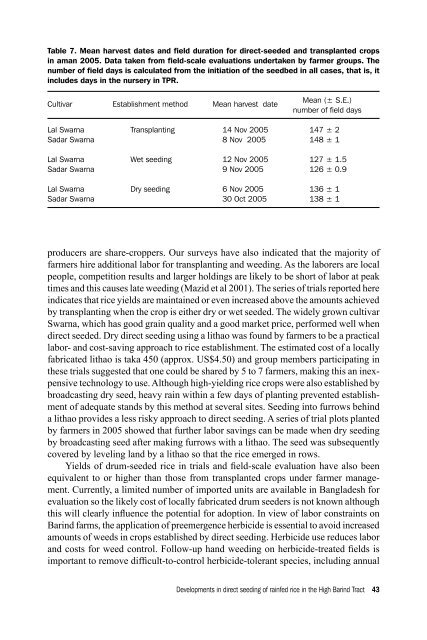Download (2461kB) - University of Greenwich
Download (2461kB) - University of Greenwich
Download (2461kB) - University of Greenwich
- No tags were found...
You also want an ePaper? Increase the reach of your titles
YUMPU automatically turns print PDFs into web optimized ePapers that Google loves.
Table 7. Mean harvest dates and field duration for direct-seeded and transplanted cropsin aman 2005. Data taken from field-scale evaluations undertaken by farmer groups. Thenumber <strong>of</strong> field days is calculated from the initiation <strong>of</strong> the seedbed in all cases, that is, itincludes days in the nursery in TPR.Cultivar Establishment method Mean harvest dateMean (± S.E.)number <strong>of</strong> field daysLal Swarna Transplanting 14 Nov 2005 147 ± 2Sadar Swarna 8 Nov 2005 148 ± 1Lal Swarna Wet seeding 12 Nov 2005 127 ± 1.5Sadar Swarna 9 Nov 2005 126 ± 0.9Lal Swarna Dry seeding 6 Nov 2005 136 ± 1Sadar Swarna 30 Oct 2005 138 ± 1producers are share-croppers. Our surveys have also indicated that the majority <strong>of</strong>farmers hire additional labor for transplanting and weeding. As the laborers are localpeople, competition results and larger holdings are likely to be short <strong>of</strong> labor at peaktimes and this causes late weeding (Mazid et al 2001). The series <strong>of</strong> trials reported hereindicates that rice yields are maintained or even increased above the amounts achievedby transplanting when the crop is either dry or wet seeded. The widely grown cultivarSwarna, which has good grain quality and a good market price, performed well whendirect seeded. Dry direct seeding using a lithao was found by farmers to be a practicallabor- and cost-saving approach to rice establishment. The estimated cost <strong>of</strong> a locallyfabricated lithao is taka 450 (approx. US$4.50) and group members participating inthese trials suggested that one could be shared by 5 to 7 farmers, making this an inexpensivetechnology to use. Although high-yielding rice crops were also established bybroadcasting dry seed, heavy rain within a few days <strong>of</strong> planting prevented establishment<strong>of</strong> adequate stands by this method at several sites. Seeding into furrows behinda lithao provides a less risky approach to direct seeding. A series <strong>of</strong> trial plots plantedby farmers in 2005 showed that further labor savings can be made when dry seedingby broadcasting seed after making furrows with a lithao. The seed was subsequentlycovered by leveling land by a lithao so that the rice emerged in rows.Yields <strong>of</strong> drum-seeded rice in trials and field-scale evaluation have also beenequivalent to or higher than those from transplanted crops under farmer management.Currently, a limited number <strong>of</strong> imported units are available in Bangladesh forevaluation so the likely cost <strong>of</strong> locally fabricated drum seeders is not known althoughthis will clearly influence the potential for adoption. In view <strong>of</strong> labor constraints onBarind farms, the application <strong>of</strong> preemergence herbicide is essential to avoid increasedamounts <strong>of</strong> weeds in crops established by direct seeding. Herbicide use reduces laborand costs for weed control. Follow-up hand weeding on herbicide-treated fields isimportant to remove difficult-to-control herbicide-tolerant species, including annualDevelopments in direct seeding <strong>of</strong> rainfed rice in the High Barind Tract 43
















